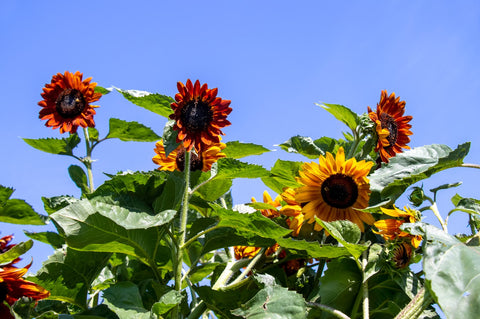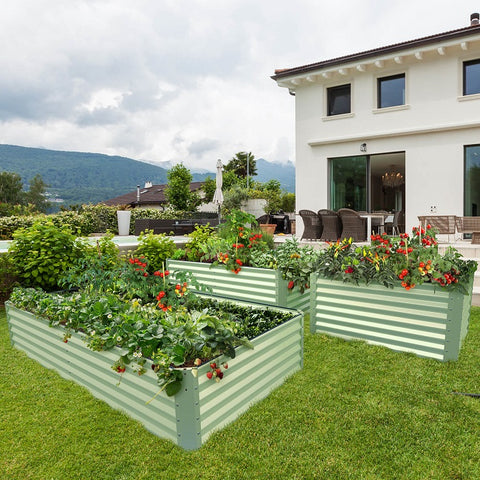Annual flowers are different flower types because they only exist for one growing season. Before you start picking flowers, it is important to know the agricultural hardiness zone you are in. Next we introduce the best perennial flowers for full sun.The following content also has some reference value for raised garden beds.
Perennial flowers thrive in full sunlight, which means they need at least six hours of direct sunlight a day. This is the minimum. Some plants, such as vegetables, require 10 hours a day. The strength of the sun varies throughout the day, being strongest in the afternoon. Sun exposure doesn't have to be all at once. A place might get 3 to 4 hours of sunshine in the morning, take a break in the middle of the day, and then get more sunshine in the evening. For many plants, partial shade in the middle of the day is ideal so they can avoid the heat.
1Black-eyed Susan
Black-eyed Susan is a wildflower native to the Savannah that grows in zones 4 through 9. It is characterized by large flowers with long yellow petals with a black or brown center and a daisy-like appearance. They grow on sturdy stems that can reach up to 3 feet tall and make great flowers for flower arrangements or vases. The plant begins to flower in mid-summer and continues until the first frost. Remove the flowers and let the plants continue to bloom. They spread quickly, so be sure to plant them in a space that allows them to grow. They are both drought-resistant and deer-resistant, and they are also attractive to birds because they love the seeds.
2Cinquechrysanthemum
Flowers come in all kinds of colors. It is a wild flower that attracts a variety of wildlife such as bees, hummingbirds, butterflies and birds. Coreopsis can grow from seeds or transplants and does well in common soil, so there is no need to worry about modifying it. Seeds need light to germinate, so make sure they are very light in color. Plants will begin to flower in mid-summer and will continue to bloom into the fall. Coreopsis is drought-tolerant and can survive with minimal watering. Separate plants in the spring or fall to produce more plants.
3Purple echinacea
Echinacea is a prairie wildflower native to the United States that grows in regions 3 to 9. The flower grows on a tall, sturdy stem with purple petals and a brown or red center. Some flowers can grow up to 6 inches wide. Plants can grow up to 3 feet tall and stretch to about 18 inches. They are a very hardy flower, resistant to heat, cold, drought, rabbits, and deer. The plant begins to flower in mid-summer and will continue throughout the fall. Cut the flowers to encourage more blooms, but leave them in the fall to attract songbirds who like to eat seeds. Butterflies, hummingbirds and bees are also known to visit the plant. Seeds should be sown 12 weeks before the ground freezes in the summer. Every 3-4 years, separate established plants in the spring or fall to prevent overcrowding and start new ones.
4Gaura
The avocado is a domesticated wildflower. It is also known as the bee flower or the whirling butterfly because the flowers look like butterflies dancing in the wind. An avocado is a rooted plant, meaning that it has a large root (the root of an avocado) that grows straight down with tapered ends, like a carrot. Smaller rootlets grow from the central root. Due to the existence of taproot, once established, it is not easy to move. This also makes it very drought tolerant. When planting, choose a place where the plants will stay. Gaura grows best in zones 6 to 9, starting to bloom in the summer and continuing into the fall. Take off the flowers to make the plants grow more. If the flowers remain on the plant, the plant may produce seeds of its own, or a new plant may grow.
5Achillea
Also known as yarrow, Achillea is a wild flower whose flower head consists of many closely packed flowers and fern-like leaves. It comes in a variety of colors, such as yellow, white, and pink, and grows in zones 5 to 8. They are easy to care for and develop very long roots, making them drought resistant. They're also resistant to deer. The flowers grow on sturdy stems and are a good choice for vases or bouquets. They begin to bloom in the spring and will continue throughout the summer. Be sure to cut the flowers to encourage more flower growth. Plant new plants after the danger of frost has passed in the spring, or no later than 12 weeks before the ground freezes in the fall. Yarrow grows and spreads easily and can benefit from splitting in the spring or autumn every 2 to 3 years. The plants grow to be about two feet tall.
6Stun Ross
Knock Out Rose is a low maintenance rose that, unlike other rose varieties, is drought tolerant, disease resistant, and requires minimal pruning. They come in seven different colors and bloom from spring until the first frost. Eliminated roses do not need to have their flower heads removed to promote new flowering, however, occasionally removing dead flowers will help the plant grow. Prune shrubs in the spring to remove any dead or broken branches. Pruning can also help shape plants. Knock Out roses can grow up to 4 feet tall.









